After slowly rolling out of bed, I hobble to the bathroom. I don’t want to move a muscle — they’re all aching and don’t want to cooperate. Sitting on the toilet is a joke, and so is trying to get back up.
No, I’m not in the midst of a juvenile arthritis flare. Nor am I recovering from an injury or fall. Nope. I’m recovering from a new regimen of exercises I started to strengthen my hips. And I am feeling it.
Why is physical therapy helpful for JA?
Physical therapy, or PT, benefits kids with JA in many ways, from helping strengthen their muscles to reducing joint contractures. The goals of PT are different for each person and may change over time, depending on a person’s progress.
Unfortunately, PT can be pretty painful. Anyone who’s gone through sessions can tell you how it can push your limits quickly. That’s not surprising, though, because you may be activating rarely used muscles or stretching out stiff joints.
A common reason for people with arthritis to go to physical therapy is to strengthen the muscles around arthritic joints. Once the muscles are healthier, they work more efficiently, so there might be less strain on the joint. But it can be a little painful in the meantime.
Getting through the short-term pain
Whenever I start new PT or other muscle-strengthening routines, I wake up sore and tender for the next few days. Since the focus of my sessions and exercises tends to be the hips, it can be uncomfortable to go about my day. Even sitting can be awkward!
While it’s essential to keep moving your joints, I treat the initial soreness of PT more like “leg day,” and allow myself a day to rest a little. (For example, I still walk and do my normal activities, just nothing too extreme.)
I also use NSAIDs on a schedule to help me cope with the pain and any extra inflammation I might deal with due to the joint working a little harder than usual. On really sore days, I sometimes use an over-the-counter topical cream for analgesic pain relief of my muscles. Check with your child’s doctor before using this.
I find PT inevitably worth the effort. Whenever I’m consistent with my PT exercises, my overall pain level starts to decrease, because my muscles work more effectively. The short-term pain at first is a small but annoying price to pay.
Sticking to the plan
It can be hard to adhere to physical therapy or another exercise regimen. JA pain can make it hard to do anything but lie on the couch. Or, it may wipe out your energy and make you not want to do exercises.
I do find it hard to feel motivated to exercise, especially when I know I might be in pain during or after my session. But understanding why the exercise helps and how it benefits me long-term helped a lot, especially as a teenager.
***
Note: Juvenile Arthritis News is strictly a news and information website about the disease. It does not provide medical advice, diagnosis, or treatment. This content is not intended to be a substitute for professional medical advice, diagnosis, or treatment. Always seek the advice of your physician or other qualified health provider with any questions you may have regarding a medical condition. Never disregard professional medical advice or delay in seeking it because of something you have read on this website. The opinions expressed in this column are not those of Juvenile Arthritis News, or its parent company, BioNews, and are intended to spark discussion about issues pertaining to juvenile arthritis.

